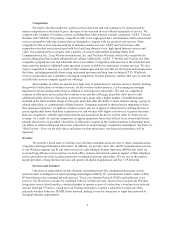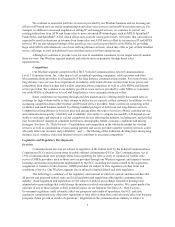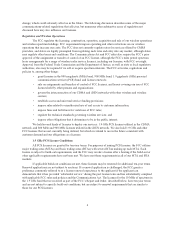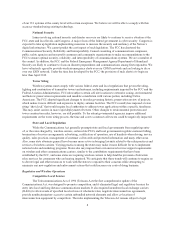Sprint - Nextel 2008 Annual Report Download - page 16
Download and view the complete annual report
Please find page 16 of the 2008 Sprint - Nextel annual report below. You can navigate through the pages in the report by either clicking on the pages listed below, or by using the keyword search tool below to find specific information within the annual report.maintain the level of revenues generated in prior periods and caused deterioration in the operating margins of our
wireless operations and our operations as a whole, the effects of which will continue if we do not attract new
subscribers and reduce our rate of churn. Our ability to retain subscribers may also be negatively affected by
industry trends related to subscriber contracts. For example, we and our competitors no longer require
subscribers to renew their contracts when making changes to their pricing plans. These types of changes could
negatively affect our ability to retain subscribers and could lead to an increase in our churn rates if we are not
successful in providing an attractive product and service mix.
We expect to incur expenses to attract new subscribers, improve subscriber retention and reduce churn,
but there can be no assurance that our efforts will result in new subscribers or a lower rate of subscriber churn.
Subscriber losses and a high rate of churn adversely affect our business, financial condition and results of
operations because they result in lost revenues and cash flow. Although attracting new subscribers and retention
of existing subscribers are important to the financial viability of our business, there is an added focus on retention
because the cost of adding a new subscriber is higher than the cost associated with retention of an existing
subscriber, and new subscribers are generally entering into contracts with lower average revenue per subscriber
than the subscribers leaving our network.
As the wireless market matures, we must increasingly seek to attract subscribers from competitors and face
increased credit risk from first-time wireless subscribers.
We and our competitors increasingly must seek to attract a greater proportion of new subscribers from
each other’s existing subscriber bases rather than from first-time purchasers of wireless services. Recently, we
have not been able to attract post-paid subscribers at the same rate as our competitors and have had a net loss of
post-paid subscribers during each of the last three fiscal years ending December 31, 2009. In addition, the higher
market penetration also means that subscribers purchasing wireless services for the first time, on average, have a
lower credit score than existing wireless users, and the number of these subscribers we are willing to accept is
dependent on our credit policies. To the extent we cannot compete effectively for new subscribers, our revenues
and results of operations will be adversely affected.
Competition and technological changes in the market for wireless services could negatively affect our average
revenue per subscriber, subscriber churn, operating costs and our ability to attract new subscribers, resulting
in adverse effects on our revenues, future cash flows, growth and profitability.
We compete with a number of other wireless service providers in each of the markets in which we
provide wireless services, and we expect competition to increase as additional spectrum is made available for
commercial wireless services and as new technologies are developed and launched. As competition among
wireless communications providers has increased, we have created pricing plans that have resulted in declining
average revenue per subscriber, for voice and data services, a trend that we expect will continue. Competition in
pricing and service and product offerings may also adversely impact subscriber retention and our ability to attract
new subscribers, with adverse effects on our results of operations. A decline in the average revenue per
subscriber coupled with our declining number of subscribers will negatively impact our revenues, future cash
flows, growth and overall profitability, which, in turn, could impact our ability to meet our financial obligations.
The wireless communications industry is experiencing significant technological change, including
improvements in the capacity and quality of digital technology and the deployment of unlicensed spectrum
devices. This change causes uncertainty about future subscriber demand for our wireless services and the prices
that we will be able to charge for these services. In addition, due, in part, to current economic conditions, we are
carefully monitoring our spending, and we are targeting how and where we spend our capital on network and
service enhancements. Spending by our competitors on new wireless services and network improvements could
enable our competitors to obtain a competitive advantage with new technologies or enhancements that we do not
offer. Rapid change in technology may lead to the development of wireless communications technologies or
alternative services that are superior to our technologies or services or that consumers prefer over ours. If we are
unable to meet future advances in competing technologies on a timely basis, or at an acceptable cost, we may not
be able to compete effectively and could lose subscribers to our competitors.
14
























